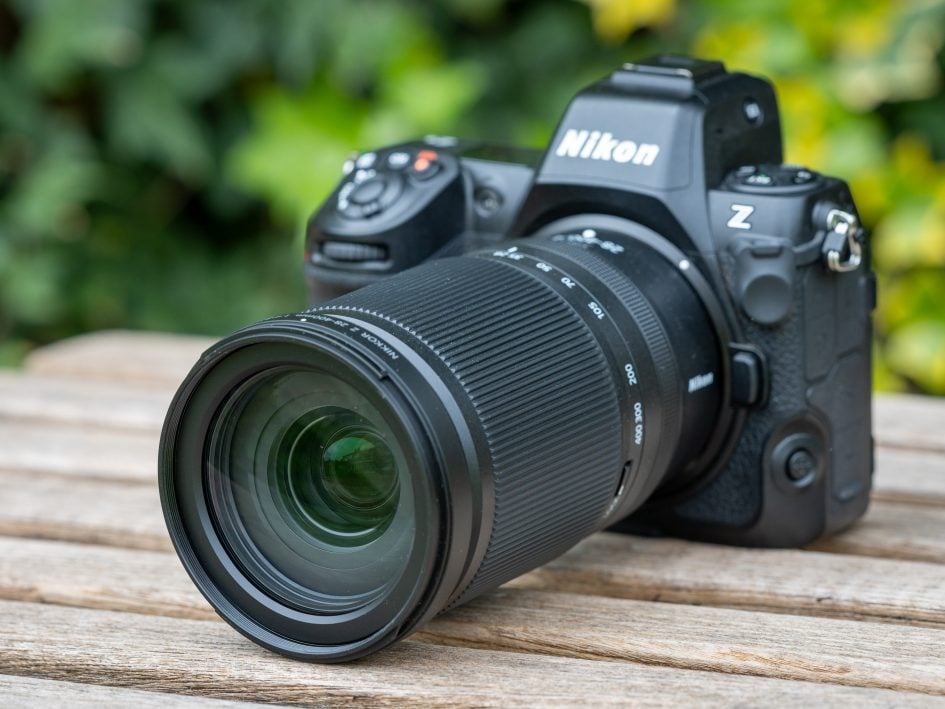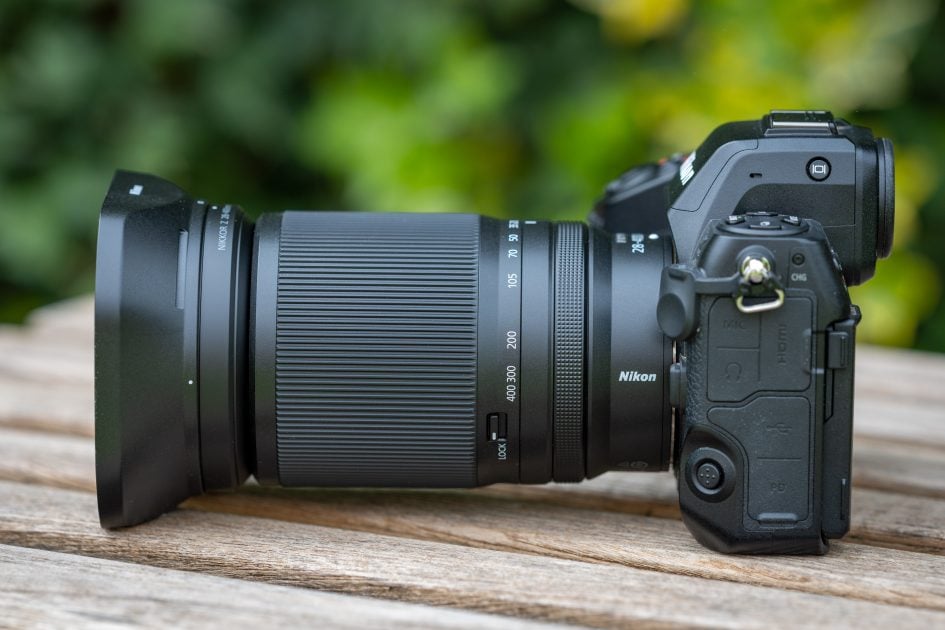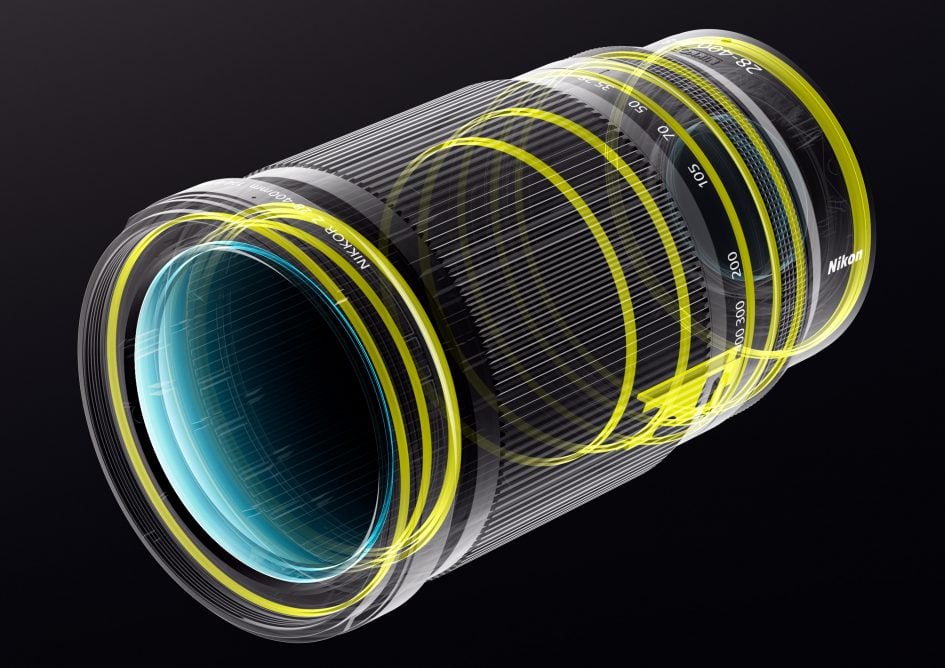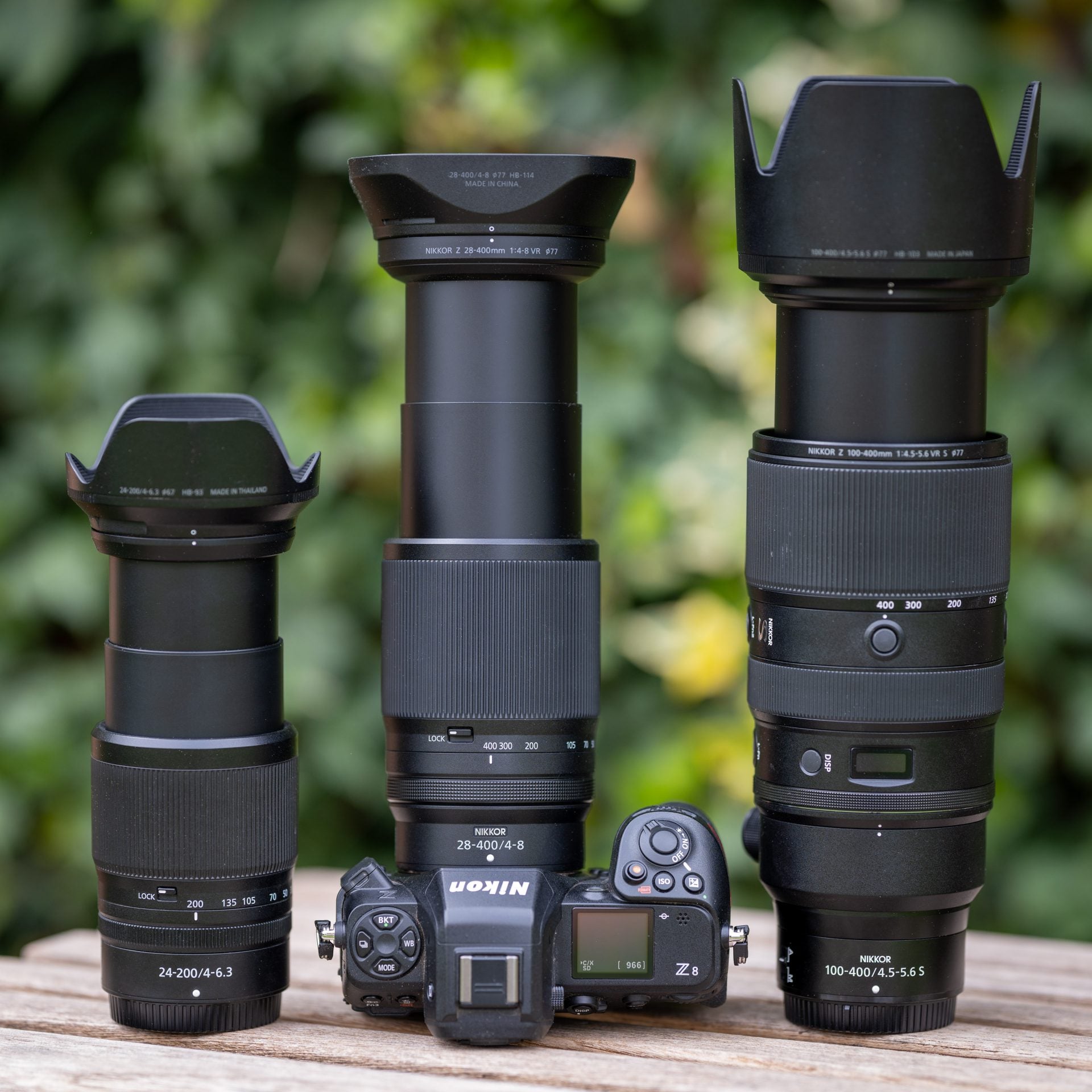Nikon Z 28-400mm f4-8 VR review
-
-
Written by Thomas
Intro
The Z 28-400mm f4-8 VR boasts a huge 14.3x zoom range and is Nikon’s second super-zoom lens for Z-mount after the Z 24-200mm f4-6.3 VR. The lens is corrected for full-frame sensors and at only 725g weight and 142mm length it’s easy to carry on extended trips. And with optical stabilization and a maximum magnification of 1:2.6 it should be a versatile lens for travel and nature photography. The lens is made in China and sells for 1549 EUR / 1297 USD / 1399 GBP.
Facts and features
Let’s compare the new Nikon Z 28-400mm f4-8 VR (“Z 28-400mm” for short) to the Nikon Z 24-200mm f4-6.3 VR (“Z 24-200mm”). I’ve also added information about potential 2-lens combos with similar coverage: the Tamron 70-300mm f4.5-6.3 Di III (“Tamron 70-300mm”) + Nikon Z 24-70mm f4 S (“Z 24-70mm”) with a combined 12.5x zoom range and the Nikon Z 100-400mm f4.5-5.6 VR S (“Z 100-400mm”) which can be combined with the Nikon Z 24-120mm f4 S (“Z 24-120mm”). And there are also some comparisons with Nikon’s F-mount AF-S 28-300mm f3.5-5.6 G ED VR (“F 28-300mm”) from 2010 which is no longer produced but can still be used via FTZ adapter on Nikon’s Z cameras. As usual I’ve rated the features with a [+] (or [++]), when it’s better than average or even state of the art, a [0] if it’s standard or just average, and [-] if there’s a disadvantage.
Size (diameter x length): 85 x 142mm (3.3 x 5.6in.) plus 24mm for the lens hood. The Z 24-200mm measures 77 x 114mm + 38mm lens hood, the Tamron 70-300mm is 77 x 150mm + 67mm lens hood, the Z 100-400mm is 98 x 222mm + 65mm lens hood. The older F 28-300mm is 83 x 115mm (plus 30mm for the FTZ adapter). All lenses in this comparison extend when zoomed to their longest focal length: The Z 28-400mm extends to a maximum total length (incl. lens hood) of 262mm, the Z 24-200 to 215mm, the Tamron 70-300mm to 277mm, the Z 100-400mm to 336mm, the F 28-300mm to 247mm. [+]
Weight: 725g (1.6 lb.) plus 31g for the lens hood. The Z 24-200mm is 565g + 22g lens hood. The Tamron 70-300mm is 577g + 62g lens hood and the Nikon Z 24-70mm f4 S would add another 525g to bring the total weight of this combo to 1164g – 408g/54% heavier than the Z 28-400mm. The Z 100-400mm is 1355g + 63g lens hood. Combining this lens with the Z 24-120mm to cover the short end adds another 657g to your bag landing you at a total of 2.1kg – almost 3 times as heavy as the Z 28-400mm. But then the combo has on average a one stop brighter aperture. The F 28-300mm is 800g + 34g lens hood + 133g for the FTZ adapter. [+]
Optics: The Nikon Z 28-400mm f4-8 VR has 21 optical elements in 15 groups including four special dispersion elements and three aspherical elements. But there’s no fluorine coating at the front nor Nikon’s special “ARNEO” anti-reflective coating which the Z 100-400mm and Z 24-120mm have. The Z 24-200mm has 19 elements in 12 groups, the Tamron 70-300mm is a 15/10 design, the Z 100-400mm is 25/20, the F 28-300mm is 19/14. [+]
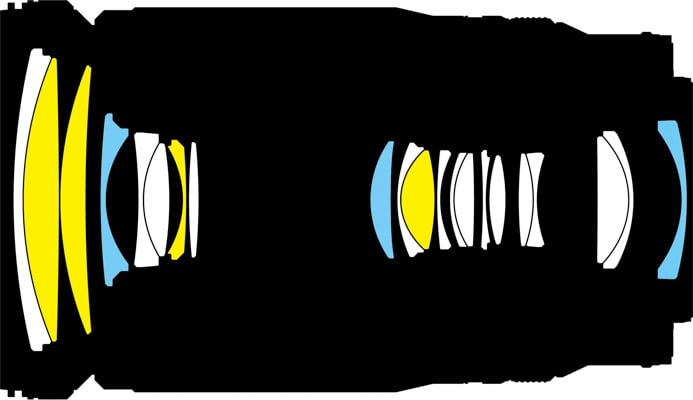
Minimum object distance is 0.2m (7.9in.) at 28mm focal length and 1.2m from 300mm focal length onwards. Maximum magnification is pretty good at 1:2.6. But it is achieved at 28mm focal length and results in an extremely short working distance of only 33mm. At 400mm the Z 28-400mm achieves 1:3.1 magnification with a much more practical working distance of 0.9m. The other lenses in this comparison all achieve their maximum magnification at their respective longest focal lengths: The Z 24-200mm achieves 1:3.4 at a working distance of 0.45m, the Tamron 70-300mm achieves 1:4.6 at 1.2m, the Z 100-400mm achieves 1:2.5 at 0.68m. [+]
Focal ratio: The maximum focal ratio of f4.0 is only maintained up to 31mm focal length. F5.6 is reached at 50mm, f6.3 at 89mm and f8.0 from 190mm onwards. The Z 24-200mm darkens a tiny bit faster when zooming in but stays at f6.3 between 80mm and 200mm. The old F 28-300mm is much better in this respect: It is f5.6 between 116mm and 300mm. [-]
Filter-thread: All lenses in this comparison use 77mm filters – except for the Z 24-200mm and the Tamron 70-300mm which use 67mm filters. The Z 24-70mm f4 S needs 72mm filters. [+]
Image stabilization: The Z 28-400mm offers optical stabilization which works in conjunction with the body-based stabilization on Nikon’s full-frame Z cameras to achieve a claimed 5 stops of stabilization over 5 axes plus an additional 0.5 stop on camera bodies which support “Synchro-VR” (like Nikon Z6II, Z7II, Z8 and Z9). This is similar to the Z 24-200mm and Z 100-400mm. For the older F 28-300mm (on an FTZ-adapter) the Z cameras only add roll correction to pitch and yaw correction from the lens’s own image stabilization. The Z 24-120mm and Tamron 70-300mm solely rely on the sensor based stabilization of Nikon’s full-frame Z-mount bodies. [+]
Aperture ring and other control elements: The multi-function control ring of the Z 28-400mm (like the Z 24-200mm and Tamron 70-300mm) is located behind the zoom ring and can be assigned to operate the aperture, exposure compensation, ISO or focus. It automatically falls back to its customary focus control when the camera is switched to manual focus. The Z 28-400mm (like the Z 24-200mm) has a switch to lock the zoom at its shortest focal length but no lens function buttons or focus limiter. The Z 24-120mm and Z 100-400mm as well as the F 28-300mm have a dedicated focus ring. [+]
Autofocus: All lenses in this comparison offer autofocus with built-in focus drive. Manual-focus override is by simply turning the control ring – if MF is assigned to it. [+]
All lenses in this comparison cover full frame sensors or can equally be used on a cropped DX camera body. [+]
The Z 28-400mm comes with the usual flimsy pouch with no strings to pull it close. The lens hood is included and reversible for transport. [0]
Sealing: The Z 28-400mm is fully weather sealed like all Z-mount lenses in this comparison. [+]
Price: The Nikon Z 28-400mm f4-8 VR costs 1549 EUR (incl. 19% VAT) / 1297 USD / 1399 GBP. The Nikon Z 24-200mm f4-6.3 VR currently sells for 864 EUR / 800 USD / 764 GBP, the Tamron 70-300mm f4.5-6.3 Di III is 600 EUR / 600 USD / 560 GBP, the Z 24-70mm f4 S is 1000 EUR/USD/GBP but typically sells for 500 EUR/USD/GBP when bought in a bundle. The Z 100-400mm f4.5-5.6 VR S is 2620 EUR / 2500 USD / 2500 GBP, the Z 24-120mm f4 S is 1150 EUR / 1100 USD / 1080 GBP. So the new Z 28-400mm is the cheapest way to reach 400mm focal length with a Z-mount lens and costs around 60% less than the combo of Z 24-120mm and Z 100-400mm. But the combo of Z 24-70mm + Tamron 70-300mm is cheaper still – when you can get a Z 24-70mm f4 S at a discount. [+]
Use with teleconverters: None of the lenses in this comparison can be used with Nikon’s teleconverters for Z-mount – except for the Z 100-400mm. [+]
The score of 1[-]/1[0]/12[+] shows that the Nikon Z 28-400mm f4-8 VR is well featured: It is a compact and lightweight 14.3x zoom lens reaching 400mm focal length at an adequate prize. It’s fully weather sealed, can go really close, and has optical image stabilization. It’s major draw-back is the meagre focal ratio: It may start at f4.0 but becomes darker real quick once you zoom in. And there might be the issue that 28mm is not wide enough for the scenery you’re trying to capture. Still, the new lens should be a very interesting addition for customers looking for a versatile zoom. Combine it with the Z 14-30mm f4 S if you need to cover the (ultra-)wide end.
Above from left to right: Nikon Z 24-200mm f4-6.3 VR, Z 28-400mm f4-8 VR, Nikon Z 100-400mm f4.5-5.6 VR S
Coverage
With its 14.3x zoom-range the Z 28-400mm covers angles of view from 75 degrees to 6.2 degrees (diagonally) while the 24-200mm starts at 84 degrees. This is visibly wider at the short end as you can see below. And on the long end the difference between lenses reaching 200mm (12.3 degrees), 300mm (8.3 degrees), 400mm (6.2 degrees) is also significant. But at least you could crop an image shot at 300mm by 1.33x to achieve the same angle of view of the lens reaching 400mm albeit at a loss of 43% of the image pixels resulting in a 25MP image from a 45MP sensor. Which might well be sufficient for the intended purpose. But cropping 2x from a 200mm shot to achieve the same angle of view as the 400mm shot means throwing 75% of the pixels away resulting in an 11MP image. This starts to become borderline in quality if you want to view/print big.
Above: Nikon Z 28-400mm f4-8 VR coverage on a full-frame camera at 28mm (left) and 400mm (right)
Above: Nikon Z 24-200mm f4-6.3 VR coverage on a full-frame camera at 24mm (left) and 200mm (right)
Above: Nikon Z 100-400mm f4.5-5.6 VR S coverage on a full-frame camera at 100mm (left) and 400mm (right)
Above: Tamron 70-300mm f4.5-6.3 Di III coverage on a full-frame camera at 70mm (left) and 300mm (right)
Using the Z 28-400mm f4-8 VR on a cropped sensor results in a further reduction in angle of view equivalent to 42-600mm focal length. Btw: Looking closely at the 400mm shots reveals that at a shooting distance of approx. 60m the Z 28-400mm achieves around 4% less magnification than the Z 100-400mm f4.5-5.6 VR S.
So the Z 28-400mm f4-8 VR is very versatile with its broad zoom range easily covering situations which so far needed a two lens set. But starting at 28mm makes the short end a little restricted especially when you’re shooting with a cropped sensor body. But then you could cover the wider angles with the Z 14-30mm f4.0 S and get an enormous 29x zoom range with just two lenses.
Focus and zoom
Focus accuracy and repeatability is critical to consistently produce sharp shots. Repeatability (the accuracy of focus on the same subject after repeated focus-acquisition) of the Nikon Z 28-400mm f4-8 VR is good (measured 95.5% in Reikan FoCal) at 240mm focal length with only one mild outlier over a series of 40 shots. The lens shows a higher variance when it focuses from a closer distance than from infinity. At 400mm focal length the lens focuses in around 0.6 sec from infinity to 3.8m (1:10 magnification) on a Z8 which is pretty fast.
The zoom ring has a throw of 95 degrees between 28mm and 400mm focal length. It has a 58mm wide rubber surface with a good grip and moves with a bit of resistance. Still, the lens suffers from zoom creep so it’s good to have the zoom lock switch. The focus/control ring is 8mm wide and is located closer to the camera. It has no rubberized surface but moves smoothly and can be operated with one finger.
AF-operation of the lens in photo-mode can hardly be heard from the outside or when recording video with the built-in microphone. Turning the zoom ring produces only a very slight friction noise.
As you pull focus, you’ll notice a bit of focus breathing: The image became 3% more magnified when I adjusted focus from infinity to 3.8m at 400mm focal length. This is hardly distracting when shooting videos. And at the wide end focus breathing is almost non-existent.
I also tested whether Nikon’s zoom lens allows you to change the focal length without altering its focus. This characteristic is called parfocal. I focused the lens at 400mm and then zoomed back checking focus on the way. The Z 28-400mm f4-8 VR is not parfocal although some control loop is trying to reduce the focus shift. See the following 100% crops shot at 105mm f6.7 before and after re-focusing:

So when shooting stills you need to re-focus after changing the focal length and when shooting video you should have continuous AF activated.
Image stabilization
To test the effectiveness of the image stabilization with the Nikon Z 28-400mm f4-8 VR on a Nikon Z8 camera body, I did a series of 160 test-shots hand-held at 400mm focal length with shutter speeds from 1/400 of a second down to 1/12 sec. I used the shots at 1/400 sec with VR=off as reference of how good my handholding was at the time of the test and Reikan FoCal did the chore of evaluating the sharpness of all shots.
Here’s the results: With VR=on the combined stabilization from lens and camera produced only one strong and four mild outliers in the 80 shots from 1/400 down to 1/50 sec (3 stops) but the rest was clearly better than the average sharpness at 1/640 sec with VR=off. At 1/25 sec (4 stops) one third of the shots were outliers. At slower shutter speeds results became very erratic. I’d rate this as 4 stops of stabilizing power but wouldn’t go beyond 3 stops (i.e. 1/50 sec at 400mm focal length) to be on the safe side for handholding the lens when you cannot support your back or arms. This is below Nikon’s claim of 5.5 stops but still good.
Next check out my quality results!
Check prices on the Nikon Z 28-400mm f4-8 VR at B&H, Adorama, WEX UK or Calumet.de. Alternatively get yourself a copy of my In Camera book, an official Cameralabs T-shirt or mug, or treat me to a coffee! Thanks!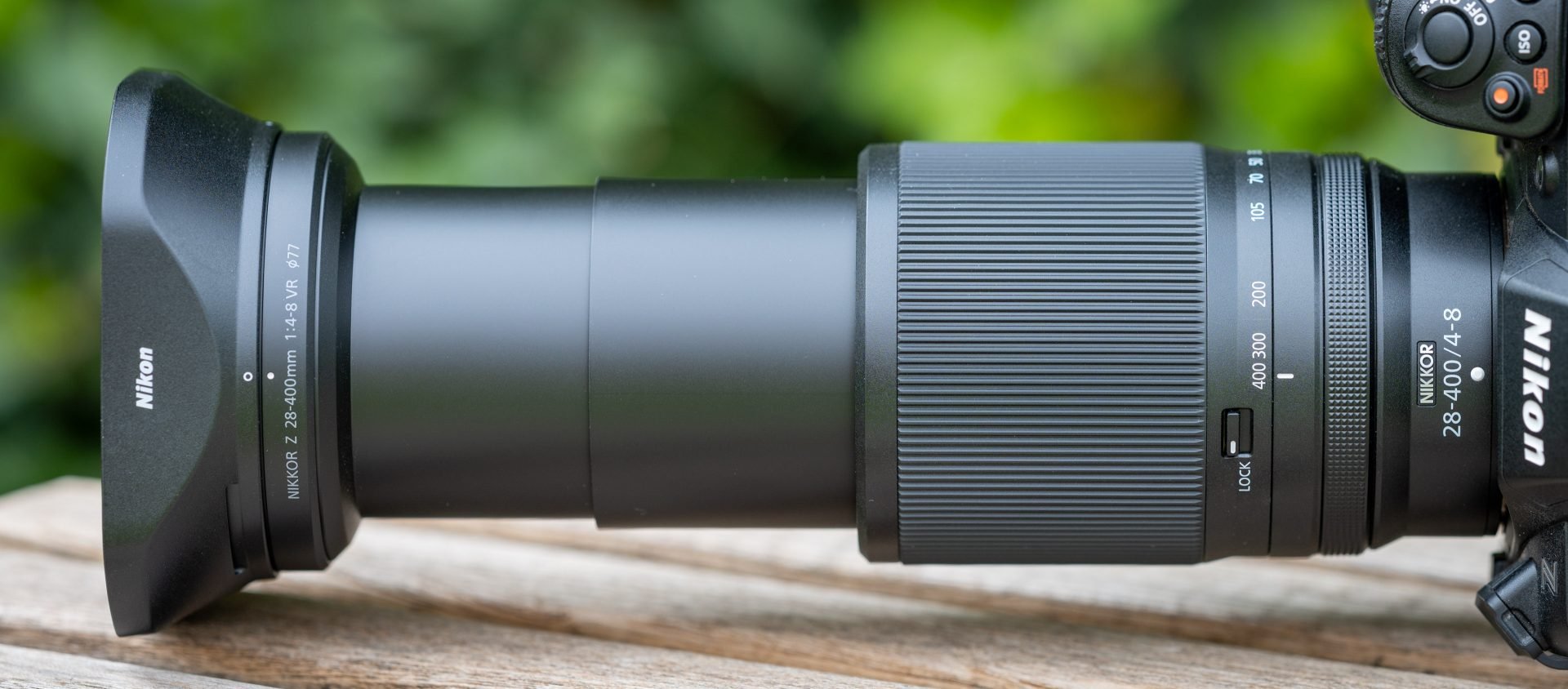
 The Z 28-400mm f4-8 VR offers an enormous 14.3x zoom range in a pretty compact and lightweight package. Its optical image stabilization helps compensate for the lowly focal ratio of f8.0 at the long end and supports handheld shooting even at 400mm focal length. It certainly is one of the softer lenses in Nikon’s Z line-up but if you refrain from pixel-peeping and normally prefer viewing at 4k resolution you will not be disappointed. And although not exactly cheap the lens still offers a good price/performance ratio. If you want to cover the wide end and reach 400mm focal length in one lens the Z 28-400mm f4-8 VR is without alternative: Recommended - especially for those who want to travel light and not change lenses in the middle of things!
The Z 28-400mm f4-8 VR offers an enormous 14.3x zoom range in a pretty compact and lightweight package. Its optical image stabilization helps compensate for the lowly focal ratio of f8.0 at the long end and supports handheld shooting even at 400mm focal length. It certainly is one of the softer lenses in Nikon’s Z line-up but if you refrain from pixel-peeping and normally prefer viewing at 4k resolution you will not be disappointed. And although not exactly cheap the lens still offers a good price/performance ratio. If you want to cover the wide end and reach 400mm focal length in one lens the Z 28-400mm f4-8 VR is without alternative: Recommended - especially for those who want to travel light and not change lenses in the middle of things!